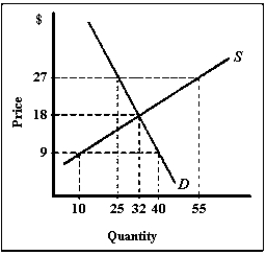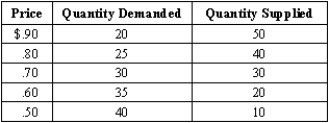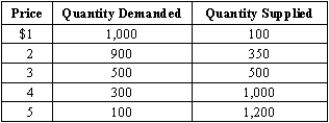A) $27 and 25 units, respectively.
B) $9 and 25 units, respectively.
C) $18 and 32 units, respectively.
D) $9 and 10 units, respectively.
E) $27 and 55 units, respectively.
Correct Answer

verified
Correct Answer
verified
Multiple Choice
A market is in equilibrium
A) when the government imposes price controls.
B) when the price is low.
C) where the demand and supply curves intersect.
D) when the price is high.
E) when equilibrium price equals equilibrium quantity.
Correct Answer

verified
Correct Answer
verified
Multiple Choice
Which of the following leads to a leftward shift of the demand curve?
A) An expectation of a decline in the product price in the future
B) A decrease in the good's own price
C) An increase in the price of a substitute
D) A decrease in the price of a complement
E) An increase in the number of consumers
Correct Answer

verified
Correct Answer
verified
True/False
Exhibit 3-3  -A market is in equilibrium when a price is low enough for all consumers to afford.
-A market is in equilibrium when a price is low enough for all consumers to afford.
Correct Answer

verified
Correct Answer
verified
True/False
The demand schedule is a table or list of the prices and corresponding quantities demanded of a particular good or service.
Correct Answer

verified
Correct Answer
verified
Multiple Choice
When there is an increase in quantity supplied,
A) producers are forced to supply more by government mandate.
B) producers are displaying a decreased willingness to produce because price has risen.
C) technology must have improved.
D) there must have been an increase in output price, ceteris paribus.
E) consumers are unlikely to buy the additional product.
Correct Answer

verified
Correct Answer
verified
Multiple Choice
A supply schedule is a
A) table of prices and quantities people are willing to sell at each price.
B) graph of prices and quantities supplied.
C) graph of costs and associated quantities supplied.
D) table of prices and quantities people are willing to buy at each price.
E) graph of prices and revenues.
Correct Answer

verified
Correct Answer
verified
True/False
When a shortage exists in a market, the actual price is greater than the equilibrium price.
Correct Answer

verified
Correct Answer
verified
Multiple Choice
Exhibit 3-2  -In the market represented in Exhibit 3-2, if price is $.50,
-In the market represented in Exhibit 3-2, if price is $.50,
A) producers are not able to sell all they are willing to sell.
B) a surplus of 30 units results.
C) producers are willing to produce more than is being purchased.
D) consumers are willing to buy more than is being produced.
E) consumers are willing to buy the same amount as that being produced.
Correct Answer

verified
Correct Answer
verified
Multiple Choice
Exhibit 3-1  -Consider the market described by the schedule in Exhibit 3-1. At a price of $5 per unit,
-Consider the market described by the schedule in Exhibit 3-1. At a price of $5 per unit,
A) the quantity traded is 1,000 units.
B) there is a shortage.
C) the quantity sold is 1,800 units.
D) there is a surplus of 1,100 units.
E) the quantity purchased is 1,000 units.
Correct Answer

verified
Correct Answer
verified
Multiple Choice
Which of the following would not affect the supply of automobiles?
A) A decrease in the number of automobile producers
B) An increase in the price of steel
C) An increase in the productivity of workers
D) An increase in the price of motor oil
E) An improvement in the technology of automobile manufacturing
Correct Answer

verified
Correct Answer
verified
Multiple Choice
When there is a decrease in supply, all else held equal,
A) equilibrium price falls, demand increases, and equilibrium quantity increases.
B) equilibrium price falls, demand does not change, and equilibrium quantity increases.
C) equilibrium price rises, quantity demanded decreases, and equilibrium quantity decreases.
D) equilibrium price falls, quantity demanded decreases, and equilibrium quantity decreases.
E) equilibrium price rises, demand does not change, and equilibrium quantity increases.
Correct Answer

verified
Correct Answer
verified
Multiple Choice
When a market equilibrium is achieved,
A) those who are willing to pay the most for the good obtain it.
B) government regulation will have succeeded.
C) anyone who has the skills to produce the good sells some.
D) shortages and surpluses become minor.
E) anyone who is willing to pay anything for the good obtains it.
Correct Answer

verified
Correct Answer
verified
Multiple Choice
If there is a surplus of a product, we can conclude that
A) the product's price is above equilibrium.
B) the product's price is too low for equilibrium.
C) quantity demanded exceeds quantity supplied.
D) the product's price will rise.
E) consumers want to buy more than is being made available by producers.
Correct Answer

verified
Correct Answer
verified
True/False
When economists say that the demand for a product has increased, they mean that consumers are willing to buy more of the product at any given price.
Correct Answer

verified
Correct Answer
verified
Multiple Choice
Exhibit 3-2  -If price is below equilibrium,
-If price is below equilibrium,
A) demand is too low for equilibrium.
B) the income and substitution effects will cause the price to rise.
C) quantity supplied exceeds quantity demanded, and a shortage exists.
D) quantity demanded exceeds quantity supplied, and a shortage exists.
E) demand will increase.
Correct Answer

verified
Correct Answer
verified
True/False
If the demand curve for product X shifts to the left as the price of product Y increases, then X and Y are complementary goods.
Correct Answer

verified
Correct Answer
verified
Multiple Choice
Which of the following would be a likely cause for the decreases in gasoline prices after 2014?
A) Increases in gasoline demand
B) Increases in U.S.oil production
C) Higher production costs for gasoline
D) Rapid economic and employment growth in the United States
E) Decreases in oil supply from the Middle East
Correct Answer

verified
Correct Answer
verified
Multiple Choice
If the government decides to pay producers of houses $5,000 for every house they build,
A) the opportunity cost of producing a house will fall.
B) demand for housing will increase.
C) housing will no longer be scarce.
D) consumers will buy more houses, even if the price does not fall.
E) producers will be willing to build more houses, even if the price does not rise.
Correct Answer

verified
Correct Answer
verified
Multiple Choice
If it is discovered that using a smartphone regularly causes brain cancer, then in the market for smartphones,
A) equilibrium price will fall and equilibrium quantity will rise.
B) equilibrium price and equilibrium quantity will fall.
C) there will be no change in equilibrium price or quantity.
D) equilibrium price will rise as demand for computers decreases.
E) equilibrium price will rise as supply decreases.
Correct Answer

verified
Correct Answer
verified
Showing 61 - 80 of 166
Related Exams